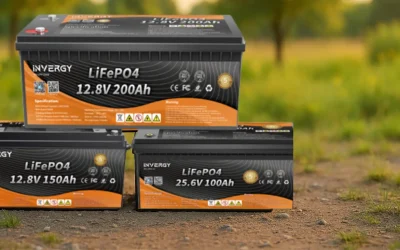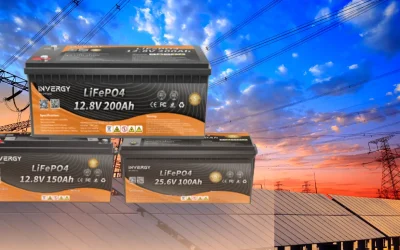In the world of energy storage, LiFePO4 batteries and lead-acid batteries have key differences. They serve different needs and environments. Knowing these differences is vital for those looking for reliable power solutions.
Recent studies show LiFePO4 batteries often last longer than lead-acid batteries. This makes comparing them important for those needing long-lasting energy storage. By looking at each technology’s strengths and weaknesses, users can make better choices that meet their needs.
Key Takeaways
- LiFePO4 batteries generally offer a longer lifespan compared to lead-acid batteries.
- Understanding battery longevity is key for making smart purchase decisions.
- Power reliability varies between technologies, affecting what you choose.
- Exploring factors that affect battery life can improve your experience.
- Choosing the right battery type can boost performance and efficiency.
Introduction to Battery Technologies
Battery technology has grown a lot, meeting the need for better energy storage. LiFePO4 and lead-acid batteries are key in powering many devices and systems worldwide. LiFePO4 is safer and more efficient than old lead-acid batteries.
Today’s battery tech offers longer life and better performance. Industries need reliable energy storage more than ever. LiFePO4 is becoming popular because it lasts longer and is better for the environment than lead-acid batteries.
Knowing about these technologies helps us choose the right energy storage. This affects everything from electric cars to green energy systems. Battery tech keeps getting better, making energy use more efficient and green.
Understanding LiFePO4 Batteries
“LiFePO4” stands for lithium iron phosphate, a strong and flexible type of lithium-ion battery. It’s known for its reliable performance and safety. This makes it popular in electric cars and storing renewable energy. Knowing about LiFePO4 and its benefits helps people choose the right battery technology.
What is LiFePO4?
LiFePO4 batteries use lithium iron phosphate as the cathode material. This makes them less likely to overheat, unlike other lithium-ion batteries. This safety feature is great for places that need a lot of power.
Key Features of LiFePO4 Batteries
LiFePO4 batteries have many good points that make them stand out. Some of these include:
- Enhanced Safety: The stable chemistry of lithium iron phosphate reduces risks such as thermal runaway.
- Long Cycle Life: These batteries can withstand numerous charge and discharge cycles, often lasting over 2000 cycles.
- Lower Toxicity: Compared to lead-acid or cobalt-based batteries, LiFePO4 poses fewer environmental risks, making it a sustainable choice.
- High Stability: The inherent stability of this battery chemistry leads to increased efficiency, providing reliable energy output in diverse conditions.
By looking at the benefits, we can see why lithium iron phosphate batteries are so valuable. Their impressive features make them popular in many fields.
Overview of Lead-Acid Batteries
Lead-acid batteries have been around for over a century. They are known for their reliability and versatility. This overview covers their construction, how they work, and why they’re used in many places.
These batteries use lead dioxide and sponge lead. They work by charging and discharging. This makes them key in many fields.
What are Lead-Acid Batteries?
Lead-acid batteries can be charged again and again. They use lead and sulfuric acid to make electricity. Their design is simple and strong, making them popular.
Over time, they’ve gotten better. Now, we have sealed batteries that last longer. They’re good at handling sudden power needs and are affordable.
Common Applications of Lead-Acid Batteries
Lead-acid batteries are used in many areas. Here are some examples:
- Automotive: They start cars, power lights, and ignition systems.
- Renewable Energy: They store solar energy for when it’s needed most.
- Industrial: They power forklifts and electric vehicles in factories and warehouses.
- Uninterruptible Power Supplies (UPS): They provide quick backup power in data centers.
Comparative Lifespan of LiFePO4 and Lead-Acid Batteries
The lifespan of batteries is key when choosing between LiFePO4 and lead-acid batteries. LiFePO4 batteries last much longer, thanks to their strong chemical makeup. This means they can handle many charge cycles without losing much power.
Lead-acid batteries, on the other hand, have a shorter lifespan. They need to be replaced more often, which can be costly. Their lifespan also depends on how deeply they are discharged and how they are used.
Cycle Life of LiFePO4 Batteries
LiFePO4 batteries are known for their long cycle life, often going over 2000 cycles. Their durability means they can be charged and discharged many times without losing much power. This makes them last longer and need to be replaced less often.
Cycle Life of Lead-Acid Batteries
Lead-acid batteries, by contrast, have a cycle life of 300 to 800 cycles. This shorter lifespan means they need to be replaced more frequently. Their lifespan can also be affected by how deeply they are discharged and how they are used.
Factors Affecting Battery Lifespan
Many things can affect how long a battery lasts, regardless of its type. Important factors include:
- Depth of Discharge (DoD): Discharging batteries too deeply can harm their lifespan, more so for lead-acid batteries.
- Temperature: Very hot or cold temperatures can damage batteries, shortening their life.
- Usage Patterns: Constantly charging and discharging batteries can wear them out faster.
| Battery Type | Typical Cycle Life | Factors Influencing Lifespan |
|---|---|---|
| LiFePO4 | 2000+ cycles | DoD, temperature, usage patterns |
| Lead-Acid | 300-800 cycles | DoD, temperature, usage patterns |
Energy Density Comparison
LiFePO4 and lead-acid batteries have different energy densities. This affects how they are used in various fields. Knowing these differences helps in choosing the right battery.
The performance and efficiency of these batteries depend on their energy density. This is key for making informed decisions.
Energy Density of LiFePO4 Batteries
LiFePO4 batteries have a higher energy density than lead-acid batteries. They store more energy per weight, with a range of 90 to 160 Wh/kg. This makes them great for electric vehicles and renewable energy systems because they are lightweight and compact.
Energy Density of Lead-Acid Batteries
Lead-acid batteries have a lower energy density, averaging 30 to 50 Wh/kg. They are affordable and reliable but heavier. This means you might need more batteries to get the same energy as LiFePO4 batteries.
Importance of Energy Density in Applications
Energy density is very important in applications. Higher density means more efficiency, longer use, and less weight in electric vehicles. It also helps in storing energy more efficiently for renewable systems, supporting sustainability.
Understanding the differences between LiFePO4 and lead-acid batteries helps in choosing the best one for your needs.
Depth of Discharge (DoD) Considerations
Depth of discharge (DoD) is key to battery performance. It helps users get the most out of their batteries. This is true for both LiFePO4 and lead-acid batteries.
What is Depth of Discharge?
Depth of discharge shows how much of a battery’s capacity is used. For example, if a 100Ah battery is used up to 50Ah, its DoD is 50%. Keeping an eye on DoD is important for battery life and efficiency.
DoD in LiFePO4 Batteries
LiFePO4 batteries can handle deeper discharges without losing much life. This makes them great for situations needing lots of power. They stay strong even when deeply discharged.
DoD in Lead-Acid Batteries
Lead-acid batteries, on the other hand, should not be discharged too far. They work best up to 50% discharge. Going beyond this can shorten their life. Knowing this helps choose the right battery for your needs.
Maintenance-Free Performance of LiFePO4 Batteries
LiFePO4 batteries are a big step up from old lead-acid batteries. They don’t need the same upkeep, making life easier for users. This part talks about how LiFePO4 batteries make life simpler for people in different situations.
How LiFePO4 Batteries Enhance Convenience
LiFePO4 batteries are great because they need almost no care. Users get to enjoy:
- No need for regular checks on electrolyte levels.
- Elimination of the need for topping up with water.
- Less risk of damage due to sulfation.
This means users have more time for their work, not battery care. They get a battery that lasts longer and works better, all the time.
Maintenance Requirements of Lead-Acid Batteries
Lead-acid batteries, on the other hand, need a lot of care. Here’s what’s needed:
- Periodic checking of fluid levels.
- Topping up with distilled water when necessary.
- Cleaning terminals and connections to prevent corrosion.
This care can take up a lot of time and is often forgotten. It can make the battery less efficient and shorter-lived. This makes LiFePO4 batteries a better choice for those who want something reliable and easy to use.
Impact of Temperature on Battery Life
Temperature is key to how well batteries work and last. Knowing how LiFePO4 and lead-acid batteries react to different temperatures helps users choose the right battery for their needs. Extreme temperatures can harm battery efficiency and lifespan.
Temperature Effects on LiFePO4 Batteries
LiFePO4 batteries stand out for their ability to handle a wide range of temperatures. They work well from -20°C to 60°C. This means they perform well in both hot and cold weather, making them versatile.
Studies show that LiFePO4 batteries keep their performance steady across different temperatures. This leads to a longer battery life compared to other types.
Temperature Effects on Lead-Acid Batteries
Lead-acid batteries, though common, don’t handle temperature changes as well. Their performance drops when it’s very cold or very hot. In cold, they can’t fully charge, which can cause damage over time.
In hot weather, lead-acid batteries can corrode faster. This also shortens their life. So, it’s important to understand how lead-acid batteries react to temperature to use them effectively.
| Battery Type | Temperature Range | Performance Characteristics |
|---|---|---|
| LiFePO4 | -20°C to 60°C | Excellent capacity retention, minimal performance drop in temperature extremes |
| Lead-Acid | -10°C to 50°C | Notable performance decline in extreme temperatures, risk of sulfation in cold |
Environmental Considerations and Recycling
It’s key to understand the environmental impact of battery tech. The recycling methods and their effects on the planet show how green different batteries are. We’ll look at how LiFePO4 and lead-acid batteries are recycled and their environmental footprint.
Recycling LiFePO4 Batteries
LiFePO4 batteries are better for the planet because they’re easier to recycle. The recycling process for LiFePO4 is simple, making it efficient. This means we don’t need to mine as much, which is good for the earth.
The materials in LiFePO4 batteries can be used over and over again. This makes recycling them a sustainable option.
Recycling Lead-Acid Batteries
Recycling lead-acid batteries is tricky because lead is harmful. Even though many lead-acid batteries are recycled, bad disposal can harm the environment. Lead can hurt animals and ecosystems if not handled right.
It’s vital to have strict rules for recycling lead-acid batteries. This helps keep the environment safe from lead pollution.
Environmental Impact Comparison
The environmental effects of LiFePO4 and lead-acid batteries are quite different. LiFePO4 is better for the planet because it’s less toxic and has a greener lifecycle. On the other hand, lead-acid recycling can be risky if not done right.
Cost of Ownership: LiFePO4 vs Lead-Acid
Looking at the cost of owning batteries, we see both upfront costs and long-term savings. This comparison highlights the initial price gap between LiFePO4 and lead-acid batteries. It also shows the long-term financial gains of choosing LiFePO4.
Initial Purchase Cost
The cost of buying batteries affects the overall cost of ownership. Lead-acid batteries are often cheaper at first, which is good for your wallet. But, LiFePO4 batteries cost more upfront. It’s important to think about the total cost over the battery’s life.
Long-Term Savings with LiFePO4 Batteries
LiFePO4 batteries save money in the long run. These savings come from several areas:
- Extended Lifespan: LiFePO4 batteries last longer than lead-acid ones, meaning you don’t need to replace them as often.
- Lower Maintenance Costs: LiFePO4 batteries need little upkeep, unlike lead-acid batteries that require regular maintenance.
- Energy Efficiency: They use energy more efficiently, which saves money over time.
While lead-acid batteries might seem cheaper at first, LiFePO4 offers better value over time. Its durability and performance lead to long-term savings, making up for the initial cost.
Case Study: Invergy’s LiFePO4 Batteries
Life Cycle Advantage
Invergy LiFePO4 batteries are engineered for extended cycle life, deep discharge capability, and rapid recharge rates. This ensures superior performance in solar storage, EVs, and industrial applications.
Real-World Applications
Customers using Invergy’s solutions report:
-
Longer replacement intervals, reducing lifecycle costs.
-
Stable performance across temperature variations.
-
Improved reliability in renewable energy and backup systems.
Invergy’s dedication to quality, safety, and sustainability positions its LiFePO4 range as a smarter choice over lead-acid alternatives.
Conclusion
In the world of battery technology, LiFePO4 and lead-acid batteries show big differences. LiFePO4 batteries last longer and work better than lead-acid ones. They are great for storing energy today.
LiFePO4 batteries also have more energy and need less upkeep. This makes them better for our planet and saves money in the long run. Choosing LiFePO4 over lead-acid is a smart move for energy storage.
Choosing LiFePO4 means getting batteries that are reliable and efficient. This helps both homes and businesses. As we look to the future, LiFePO4 batteries are key. They offer long life and help protect our environment.




0 Comments